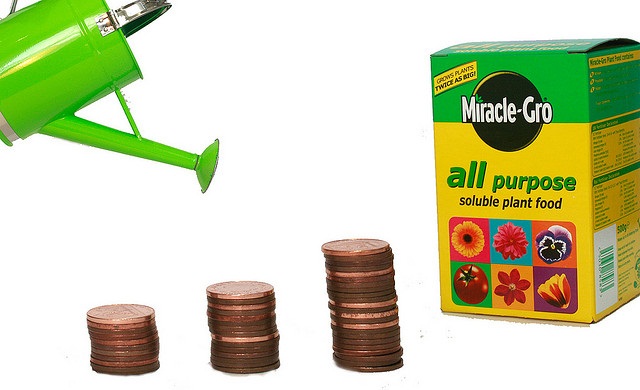It goes like this: you buy some shares and wait for the company to buy some of them back from you at a higher price. You sell them your shares and then you buy them back a lower price. The company then offers to buy some more of your shares and you do it all over again. How does that sound? Impossible? Not at all, there’s a little corner of the market where this is happening all the time.

In 2011 Dunedin Investment Trust (DNE) announced a change of investment policy and introduced a distribution policy. For those who understood the implications of this RNS – I wasn’t one of them – it was a pivotal announcement: they were going to return money back to shareholders.
Weekly chart of DNE: look what happened to the price after the 2011 announcement.
Investment trusts are little loved and often trade at a wide discount to their Net Asset Value (NAV). That is to say, if they sold all their assets and liquidated the company would be worth a lot more than the current market value. Quite often investment trusts vote to wind themselves up and return the full NAV to shareholders but they don’t have to wind-up to return money.
In their 2011 announcement, Dunedin said they would ‘return at least 50% of the capital gains made on realisations of the Company’s investments in UK lower mid-market buyouts and a substantial proportion of the net proceeds from any sales of the Company’s existing investments in third party managed funds.’
What happened next? Directors bought shares! Clever them.
In February 2012 they announced their first asset sale and in March 2012 they made their first offer to buy shares back (tender) from shareholders. The offer was for 10% of shares held @ 475p. The share price was around the 380 mark. Result.
In May 2012 they announced two asset sales, in August a third and in October they announced a second tender offer for 5% of shares held at 500p. The share price was around 380p at the time. By now I was on board and happily sold them my shares. I then bought them back.
Today they announced another asset sale and I imagine it won’t be long before another we see another tender offer.
Are there risks? Sure. They may not be able to sell their assets, the assets may fall in value, the assets may have been badly valued in first place, the market may turn and there will be a sell-off or they may change direction again. But for now, for me at least, it’s ‘game on’.
Disclosure: at the time of writing the author holds shares in DNE.
About
Susan Marmor has been trading her ISA and SIPP full time for 7 years. She has made money every year, including 2008. She believes that making money is about picking the right shares at the right time and using sound money management techniques to manage risk.
For her trading she uses a combination of sound fundamental data and technical analysis (which involves using price charts and some of the fancy bits and pieces that go with them). She runs the occasional seminar to show people what she does and how she does it.
Disclaimer:
Please keep in mind that all comments made by Susan Marmor are for educational purposes only and should not be construed as investment advice regarding the purchase or sale of securities, options, futures or any other financial instrument of any kind. Consult with your investment advisor before making an investment decision regarding any securities mentioned herein. Susan Marmor assumes no responsibility for your trading and investment results. Susan Marmor does not warrant completeness or accuracy for any observations made herein, or warrant any results from the use of the information. Susan Marmor may have a position in the securities and/or otherwise employ trading strategies that may be consistent or inconsistent with the provided strategies. There is a very high degree of risk involved in any type of trading. Past results are not indicative of future returns. Securities, options, futures and any other financial instruments can go down as well as plunge.

 Hot Features
Hot Features













